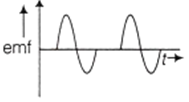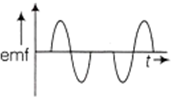 Multiple Choice Questions
Multiple Choice QuestionsA simple pendulum of length l1 has a time period of 2 s and another pendulum of length l2 has a time period of 1 s. Then, the time period of pendulum having length l1 − l2 will be
2 s
1.2 s
3 s
s
Springs of spring constants K, 2K,4K, 8K...are connected in series.A mass m kg is attached to the lower end of the last spring and the system is allowed to vibrate. The time period of oscillations is (Given, m= 40 g and k =2.0 N-cm-1)
2.12 s
0.126 s
1.26 s
0.0126 s
A pendulum made of a uniform wire of cross-sectional area A has time period T. When an additional mass M is added to its bob, the time period changes to Tm . If the Young's modulus of the material is Y, then is equal to
Which of the following graphs represents resonance for low damping ?

graph (1)
graph (2)
graph (3)
None of these
A magnet is made to oscillate with a particular frequency, passing through a coil as shown in the figure. The time variation of the magnitude of emf generated across the coil during one cycle is





A.

When north pole of magnet approaches the one face of coil, then the face of the coil becomes a north pole to oppose this motion and current flows anti-clockwise. Thus, in this case emf is developed in the coil and when it completes one half motion, it is momentarily at rest and no emf is present. Now, south pole approaches the other face of coil making this face a south pole. The current now flows in clockwise direction and again an emf is developed in the coil. This variation is shown in option (a).
A particle executes simple harmonic motion between x = − A and x = + A. The time taken for it to go from O to A/ 2 is T1 and to go from A/2 to A is T2 . Then
T1 < T2
T1 > T2
T1 = T2
T1 = 2T2
A body executes simple harmonic motion. The potential energy (PE), kinetic energy (KE) and total energy (TE) are measured as a function of displacement y. Which of the following statements is true ?
TE is zero when x = 0
PE is maximum when x = 0
KE is maximum when x = O
KE is maximum when x is maximum
A particle starts SHM from the mean position. Its amplitude is a and total energy E. At one instant its kinetic energy is 3 · Its displacement at that instant is
